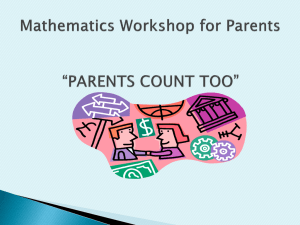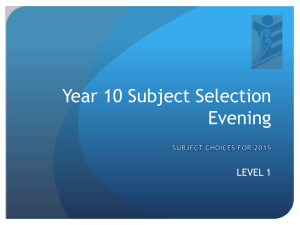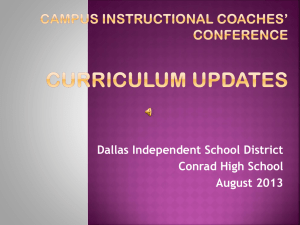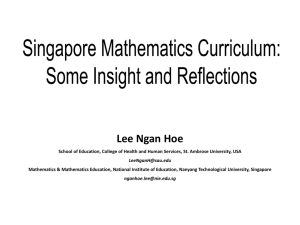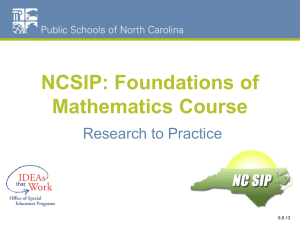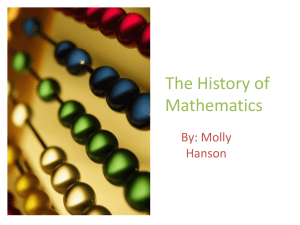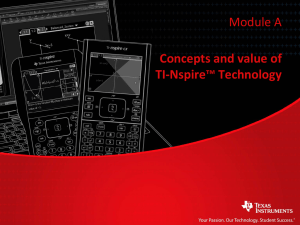Teaching Chapter 11
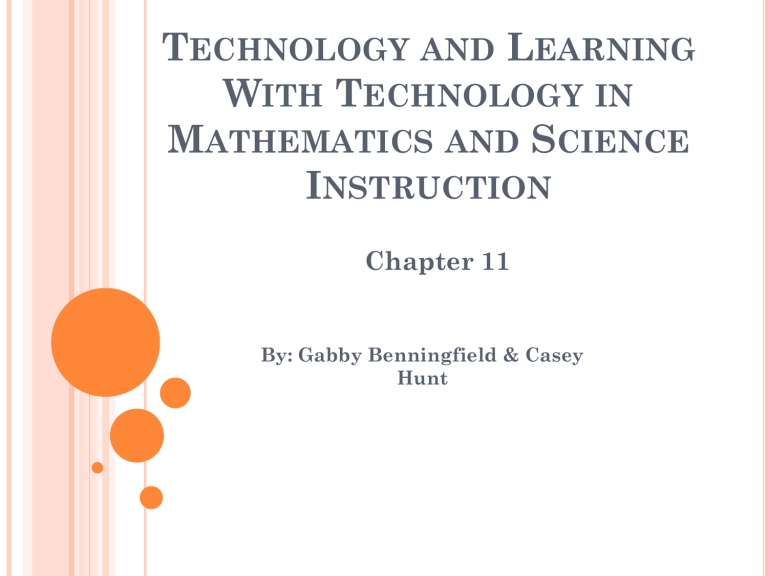
T
ECHNOLOGY AND
L
EARNING
W
ITH
T
ECHNOLOGY IN
M
ATHEMATICS AND
S
CIENCE
I
NSTRUCTION
Chapter 11
By: Gabby Benningfield & Casey
Hunt
1. While these tools are usually used more at the elementary level, researchers report that they can also improve high school students’ attitudes towards mathematics.
A. Virtual manipulates C. Calculator-based labs
B. Graphing calculators D. Computer-based tutoring
2. Without this technology tool, it is difficult, if not impossible, for students to move from the symbolic realm of f(x)=x2-3 to the equivalent graphical rendering on an x-y coordinate to its accompanying numerical representation.
A. Virtual manipulative C. Graphing calculator
B. Mathematical simulation D. Geometry software
3. These programs allow users to create and manipulate geometric constructions.
A. Calculator-based laboratory (CBL) C. Interactive or dynamic math manipulates
B. Computer algebra system (CAS) D. Interactive or dynamic geometry software
4. This software is often used to facilitate activities such as planning a fund-raising activity or analyzing data from students’ counts of colors in a bag of M&Ms or other candies.
A. Graphing calculators C. Probeware
B. Counting software D. Spreadsheets
5. Through virtual schools propose that these can be effective, some science organizations object to them as poor substitutes for “the real thing.”
A. Virtual manipulates C. Distance mentors
B. Distance education courses D. Virtual science labs
http://www.youtube.com/watch?v=Ik1BuiLy
MkY
I NTEGRATING T ECHNOLOGY F OR M ATH
Bridging the gap between abstract and concrete with virtual manipulatives
Benefits:
Abstract mathematics concepts more concrete
Flexible environments that allow exploration
Concrete representations of abstract concepts
I NTEGRATING T ECHNOLOGY F OR M ATH
Allowing Representation of Mathematical
Principles
Benefits:
Visual depiction of abstract math concepts
Environment that allows exploration
Graphing Calculators
Interactive or dynamic geometry software
Computer algebra system (CAS)
I NTEGRATING T ECHNOLOGY F OR M ATH
Supporting Mathematical Problem Solving
Benefits:
Gather data to use in problem solving
Rich, motivating, problem-solving environments
Opportunities to apply knowledge and skills
Calculator-based laboratories (CLBs. or probeware)
I NTEGRATING T ECHNOLOGY F OR M ATH
Implementing Data-Driven Curricula
Benefits:
Easy access to many data sets
Real data and statistics to support investigations
Develop skills in data analysis
Allow exploration and presenting data
I NTEGRATING T ECHNOLOGY F OR M ATH
Supporting math-related communications
Benefits:
Easy contact with math experts
Promotes social interaction
Teacher connection
I NTEGRATING T ECHNOLOGY F OR M ATH
Motivating skill building and practice
Benefits:
Motivation for practicing foundational skills
Guided instruction in a structured environment
Issues and Problems in Science Instruction
-Accountability for Standards in Science
-The Narrowing Pipeline of Scientific Talent
-Increasing Need for Scientific Literacy
-Difficulties in Teaching K-8
-Objections to Virtual Science Labs
Accountability for Standards in Science
•National Science Education Standards (NSES)
•The U.S. Department of Education and the National Science Foundation
Endorse mathematics and science curricula that “promote active learning, inquiry, problem solving, cooperative learning, and other instructional methods that motivate students”
•National Committee on Science Education Standards and Assessment stated,
“school science education must reflect science as it is practiced,” and that one goal of science education is “to prepare students who understand the modes of reasoning of scientific inquiry and can use them”
•To integrate technology in the science classroom on a regular basis, one must understand the meaning of technology in the context of science teaching and learning.
The Narrowing Pipeline of Scientific Talent
•Great concern has grown about America’s ability to compare in science, mathematics, and technology in the future.
•Females and minority students- pursing studies in math, science, and engineering fields.
•Trend could have serious consequences for the long-term economic and national security of our country
Increasing Need for Scientific Literacy
• A need for ALL citizens to be scientifically literate in order to make informed decisions that affect our country’s future.
•American’s economic and environmental progress depends on the character and quality of the science education that the nation’s school provide.
Difficulties in Teaching K-8
•Science is a rapidly changing area
•Elementary education teachers face a greater challenge
•One way to assist teachers in science is through professional development (PD). Online PD opportunities help increase elementary teachers to improve in these important areas. http://www.learner.org
www.bioedonline.org
www.k8science.org
Objections to Virtual Science Labs
•Students need to DO not just see
•Hands-on/minds-on science- engaging in in-depth investigations with objects, materials, phenomena, and ideas and drawing meaning and understanding from those experiences.
•Virtual Schools can provide the science without the danger
Technology Integration Strategies for Science Instruction
Technology Integration Strategies
Involving students in scientific inquiry through authentic online projects
Support for specific processes in scientific inquiry
Supporting science skills and concept learning
Engaging students in engineering topics through robotics
Accessing science information and tools
• Internet project provide environments that support all phases of authentic science experience
• Data Loggers
• Helps students locate & obtain info to support inquiry
• Makes data collection & analysis more manageable
• Makes phenomena easier to visualize & understand
• Helps students communicate results of inquires
• Allows students to simulate & model various scientific processes
• Provides opportunities to engage in problem solving
• Gives students experience w/ engineering principles
• Gets students thinking abt engineering careers
• Offers sources of information, lesson plans on science topics
Other science resource websites for teachers
Benefits
• Offers sources of information, lesson plans on science topics
Sample Resources and Activities
Globe Project: GLOBE Program: http://globe.gov
CBLs and spreadsheets
The Exploratorium Museum: http://www.Exploratorium.edu
Poll Everywhere text message
(use cell phones as clickers) http://www.polleverywhere.com
NASA’s Robotics Alliance project: http:robotics.nasa.gov
Telescopes in Education: http://www.telescopesineducation.com
National Science Education Standards http://www.nap.edu
Needs and Challenges in Mathematics and Science Instruction
Technologies are integral part of modern mathematics education and science education because they are essential in the field themselves.
• Mathematics and Science Content Knowledge
-Training the workforce of tomorrow
• Mathematics and Science Pedagogical Knowledge
-Must teach in engaging and motivational, while maintaining effective achievements.
• Mathematics and Science Technological
Knowledge
- Teachers must master the tools of technology
R ELATED W EBSITES
http://www.nctm.org
National Council of Teachers of Mathematics http://mathforum.org/library
Math Forum at Drexel-Internet Math Library http://education.ti.com/educationportal
Texas Instruments Resources for Educators http://www.mathomatic.org/math
Free Mathomatic computer algebra system http://www.sheppardsoftware.com/science.htm
Free science tutorials and games http://robotics.nasa.gov
International Technology and Engineering Educators
Association http://handsonmindson.org
Science website engaging in in-depth investigations with objects, materials, phenomena, and ideas and drawing meaning and understanding from those experiences.
1. While these tools are usually used more at the elementary level, researchers report that they can also improve high school students’ attitudes towards mathematics.
A. Virtual manipulates C. Calculator-based labs
B. Graphing calculators D. Computer-based tutoring
2. Without this technology tool, it is difficult, if not impossible, for students to move from the symbolic realm of f(x)=x2-3 to the equivalent graphical rendering on an x-y coordinate to its accompanying numerical representation.
A. Virtual manipulative C. Graphing calculator
B. Mathematical simulation D. Geometry software
3. These programs allow users to create and manipulate geometric constructions.
A. Calculator-based laboratory (CBL) C. Interactive or dynamic math manipulates
B. Computer algebra system (CAS) D. Interactive or dynamic geometry software
4. This software is often used to facilitate activities such as planning a fund-raising activity or analyzing data from students’ counts of colors in a bag of M&Ms or other candies.
A. Graphing calculators C. Probeware
B. Counting software D. Spreadsheets
5. Through virtual schools propose that these can be effective, some science organizations object to them as poor substitutes for “the real thing.”
A. Virtual manipulates C. Distance mentors
B. Distance education courses D. Virtual science labs


